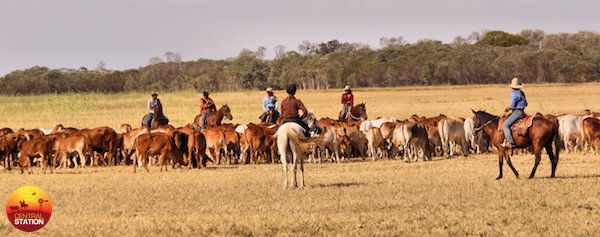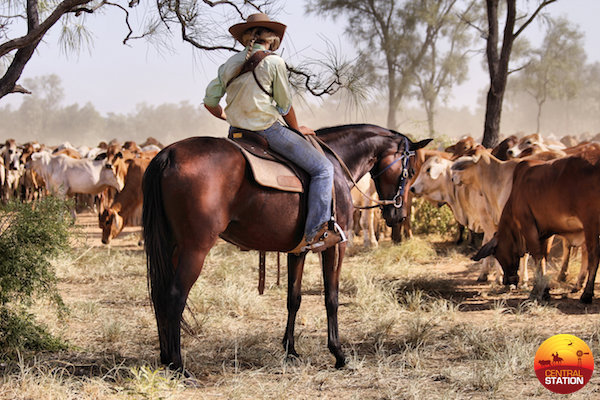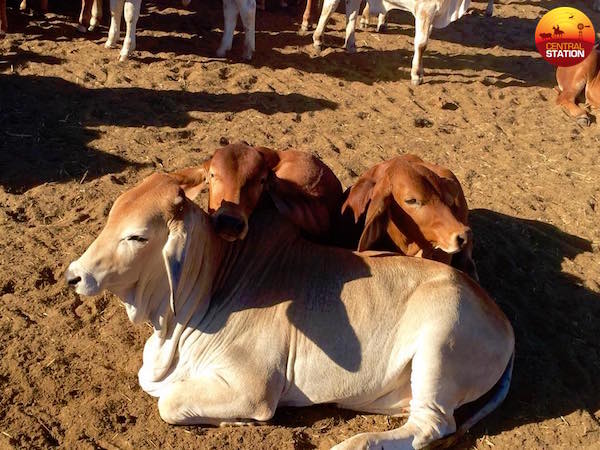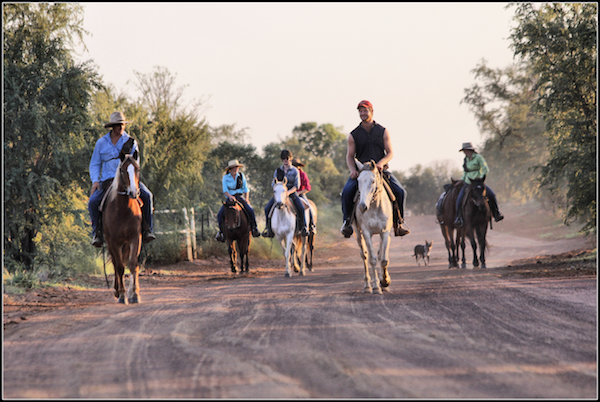No place like Mum – Mustering at Blina
Host: Blina Station
Written by Constance Wood – Manager, Blina Station.
 Holding Cattle (Photo Credit Yasmin Gray).
Holding Cattle (Photo Credit Yasmin Gray).
At Blina, we have 15 breeder paddocks and they are mustered twice a year. The reason we muster twice a year is so that our cows are able to put on weight again over the wet season and therefore get back in to calf quicker after having their weaner taken off. Brahman Cattle will only cycle again after coming back up to a certain weight.
We have a stock camp made up of about six people plus our head stockman, Matt and myself – making about nine people. Usually we have seven or eight people on horseback and one person on the motorbike. Depending on the paddock, we usually have two helicopters in the air as well.
The helicopters head out early and start to grid the paddock. The motorbike will head out to help them shift cattle. We used to do this job on horseback before the purchase of the bike about three years ago. Two experienced horseman would go out and assist the helicopters by ‘bringing along the tail’. The conservative use of the motorbike saves the energy of the horses, as usually a few cows and weaners buck out and need to be brought in with the rest of the mob.
The horseman usually take a cut from a bore and walks them out to an open area where they are ‘blocked up’. This mob becomes the coacher mob – a group of quiet, mothered up cattle that fresh cattle are mustered in to. Because they are running in to a mob of quiet cattle, the fresh cattle quickly calm down and are content to stay in the mob.
The main reason we go to all of this effort to take a mob from the bore before the main mob get in, is to ensure that the cows and calves or weaners stay “mothered up”. It is paramount to ensure that cows stay with their young. If this does not happen, it is a disaster and mustering becomes very very hard work. Often, if they can’t find their mother/mother can’t find her baby they will run back to the last place they were mothered up – the bore. This means that it can be quite a bit of hard work in the beginning to hold a mob until they mother up. Often cows buck out of the mob, as do calves and weaners. It is our job to ensure they stay in the mob and find their mum.
The key to this is a really slow start when moving cattle form a bore. Often we will slowly ride around a mob that is on water. We will start back and slowly move in, using the horsemen like a net. Then we will hold the cattle for a while. When it is time to move off, this is done very slowly and gently, with minimal noise. Matt usually puts the best riders on the tail of the mob here, as we are able to judge and read the cattle.
Sometimes we will just take a small cut, sometimes we will take everything that is on the bore – it depends on the country, the cattle and the situation. Sometimes we will receive a small mob from the helicopters and the bike. There is no set formula. The common denominator is that a mob is held to be quietened down on horseback and we wait for the main mob to come in.
Once the main mob has come in to the block up spot, the helicopters and the bike bring them in and we hold them and ‘break in’ the weaners. Often this is the first time that the weaners have seen horses, so they are really skitty and often looking for mum when they come in to the mob. We ride round the mob until you can hear the cattle stop calling out, which means that young cattle have found mum, and then they feed and settle.
 Annie and the Mob (Photo credit Kerri Back Photography).
Annie and the Mob (Photo credit Kerri Back Photography).
We then start to go through the mob and cut out cows with really small calves. Brahman calves are so resilient, they are tough little buggers and can walk a long way, but it is not worth putting a newborn calf through the stress of walking so we cut them out of the mob with mum and leave them behind. This is the perfect opportunity for us to give our horses a bit of cut out practice! The use of horses for moving cattle really shines here as I don’t think we could cut out with the minimal stress that we do without the use of a horse. Horses can quietly move through the mob with minimal disturbance, push mum and bub out without spraying the rest of the mob.
Once the little fellas and any weak cattle are cut out, weaners are settled, and everyone is paired up properly, we then start to move off toward the yards. The most important thing about moving off is that it is done slowly and quietly. Under no circumstances are the staff permitted to ‘bulge’ the cattle when first moving off. The slow start ensures that mum takes her baby and walks off. Any cows that do run back to the calves on the tail are given plenty of room to sniff the calves, usually they find their baby and both run back together into the mob.
Once we have the main mob settled, the helicopters either land, or go off to grid the rest of the paddock, sending in small mobs to the coachers during the course of the walk to the yards.
On the off chance that the calves don’t find their mum and are struggling along on the tail, the horseman will jump off our horse, grab the calf, and plonk it on the back of a Toyota in the “poddy crate” which follows behind the mob (usually driven by the cook) and they are given a taxi ride to the yards.
It can be up to a 10-15km walk to the yards from the block up point and in the bigger paddocks, some cows and calves have walked much further than this. We usually pull up in the heat of the day to allow the calves and weaners to feed and the cows to have a rest. The stock camp have their lunch and the horses get a break. On some musters, we will swap horses and the gooseneck will also follow along behind the mob.
Often we will block up along the way to shorten the mob and allow the tail to catch up before we go through a gate or if there are gaps in the mob. We block up just before we get to the yards and one helicopter will jump up in to the air to help yard up. Usually one person on horseback leads them in to a wing (a fence that comes out at an angle from the yards that is used like a funnel to get cattle in the yard efficiently.
 No Stress, Man. (Photo Credit Isla Bell).
No Stress, Man. (Photo Credit Isla Bell).
Once in the yards, the cattle are given about two hours to cool down and mother up, and we may start drafting in the afternoon, otherwise we leave the cattle in the yards overnight and draft the entire mob the following day. Try to get cattle processed as quickly and as efficiently as possible to avoid infection in newly castrated and de-horned calves.
Once the cattle are processed, they are let out of the yards as soon as possible, either in to a holding paddock, or back in to their paddock. The most important thing when letting cattle out of the yards is that they come out slowly, are held outside the yards so that they may find their calves again before walking back to water. This is paramount in ensuring that there are minimal orphaned calves. We get the odd poddy calf, but generally due to the slow start and meticulous mothering up processes that we do, we hardly get any orphaned calves.
I really am a huge believer in the use of horses to minimise stress on animals. I think that the effective use of helicopters to muster the cattle in to a holding spot is an efficient use of modern tools to get the cattle in quickly while the day is still cool and I think this teams really well with using horses to mother up and walk away to the yards. There is minimal noise and stress and all things going well – it is a really nice feeling walking in the lead or alongside a mothered up mob that is quietly poking their way toward the yards, calves and weaners at foot with their mothers.
I really love the way we muster cattle here at Blina, I think it is the perfect mix of efficiency and looking after the welfare of your animals. This piece is not saying that this is the only way to muster, but it is the way we muster here at Blina.
 Early Morning Ride. (Photo Credit Kerri Back Photography).
Early Morning Ride. (Photo Credit Kerri Back Photography).
